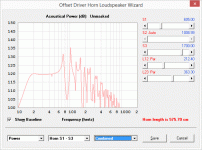There's another design I hadn't considered - an OD-TL - a TL with the driver offset in the box. It's a bit more difficult to build, but it does address the first "notch" in the response that's characteristic of TLs (and vented boxes with large vents).
....and here we go. As you can see, the notch has moved up a bit higher in frequency (which means that you have a wider passband to work with). The size is the same as the TL I provided earlier. The difficulty here is coming up with an actual folded layout that places in the driver in the right position in the OD-TL.
Attachments
T-TQWT
Hi Bach On,
Sorry about just throwing that out.
T-TQWT stands for "tapped-tapered quarter wave tube". It is similar to a transmission line in that the driver is matched w/ a 1/4 wave line (tube, pipe, duct, horn...). It is also similar to a tapped horn in that the driver is inside the line, here the difference is that the line in a TH expands from the horn throat (inside end of the line) to the mouth (opening of the line to the outside); but in a T-TQWT the line reduces in cross-section from the inside end to the mouth (another way of looking at it is: the mouth is smaller than the throat). The driver can be mounted close to both ends of the line resulting in a slightly higher midband output, but a narrower passband, or it can be mounted @ about the 1/2 way point (or 1/3) of the line for a slightly wider passband, and a comparatively higher low end output, this is what I did in the simulation in Post #12; you may note, that the Vint (internal volume) is "only" 334.72 litres.
When I find the time I'll draw you a picture to go w/ the simulation.
Regards,
Hi Bach On,
Sorry about just throwing that out.
T-TQWT stands for "tapped-tapered quarter wave tube". It is similar to a transmission line in that the driver is matched w/ a 1/4 wave line (tube, pipe, duct, horn...). It is also similar to a tapped horn in that the driver is inside the line, here the difference is that the line in a TH expands from the horn throat (inside end of the line) to the mouth (opening of the line to the outside); but in a T-TQWT the line reduces in cross-section from the inside end to the mouth (another way of looking at it is: the mouth is smaller than the throat). The driver can be mounted close to both ends of the line resulting in a slightly higher midband output, but a narrower passband, or it can be mounted @ about the 1/2 way point (or 1/3) of the line for a slightly wider passband, and a comparatively higher low end output, this is what I did in the simulation in Post #12; you may note, that the Vint (internal volume) is "only" 334.72 litres.
When I find the time I'll draw you a picture to go w/ the simulation.
Regards,
Hi Bach On,
OK, here is an example drawing what a T-TQWT for the SI HT18 as simulated in Post #12 would look like (Actually the internal closed end is about 20% larger, but it should work a little better, and it fit the drawing, also, it is not finished. But it sure was done quickly. 🙂 It helps to have a lot of drawings that you can just copy from. )
Obviously, the outside dimensions give a bigger volume than the Hornresp Vint.
Regards,
OK, here is an example drawing what a T-TQWT for the SI HT18 as simulated in Post #12 would look like (Actually the internal closed end is about 20% larger, but it should work a little better, and it fit the drawing, also, it is not finished. But it sure was done quickly. 🙂 It helps to have a lot of drawings that you can just copy from. )
Obviously, the outside dimensions give a bigger volume than the Hornresp Vint.
Regards,
Attachments
Hi mwmkravchenko,
Post #7: "...reworked it for a 15 it would pump out about another 5 db..."
I remember your Trio 12" horn loudspeaker, very nice!
http://www.diyaudio.com/forums/subwoofers/168697-trio-12-front-loaded-horn-subwoofer.html
It would be great to see your talents applied to a 15" (or maybe even 18"?) version. 🙂
Regards,
Post #7: "...reworked it for a 15 it would pump out about another 5 db..."
I remember your Trio 12" horn loudspeaker, very nice!
http://www.diyaudio.com/forums/subwoofers/168697-trio-12-front-loaded-horn-subwoofer.html
It would be great to see your talents applied to a 15" (or maybe even 18"?) version. 🙂
Regards,
Thanks, Oliver. That was fast work.
I took physics. I didn't make an A, but I made a solid B. I think I understand at least some of the physics behind a ported box. I'm nowhere near confident that I begin to understand the concept and advantages/disadvantages of the various kinds of horns.
I don't know to what degree a particular design (ahem, skillfully done) will change the raw sound of the driver. It has to make some changes to reach the increased SPL over, say, a ported box.
Our organ design has two ported boxes - as you know. I remember us talking about merging the sound of the 10 cu. ft. triangular box with the original 13 cu. ft. box. Subtle differences could impact on how well these to cabinets worked together.
I guess what I'm wondering is what impact on this blend might result from adding ANY kind of horn? Do you see what I'm trying to say?
Mark has a horn that sounds interesting. Some like a TH. Some like a TL. Some like a T-TQWT. Others dislike any and all of those. Before making a choice of what to build, I suspect it would be wise to understand their inherent characteristics of each type.
Bach On
I took physics. I didn't make an A, but I made a solid B. I think I understand at least some of the physics behind a ported box. I'm nowhere near confident that I begin to understand the concept and advantages/disadvantages of the various kinds of horns.
I don't know to what degree a particular design (ahem, skillfully done) will change the raw sound of the driver. It has to make some changes to reach the increased SPL over, say, a ported box.
Our organ design has two ported boxes - as you know. I remember us talking about merging the sound of the 10 cu. ft. triangular box with the original 13 cu. ft. box. Subtle differences could impact on how well these to cabinets worked together.
I guess what I'm wondering is what impact on this blend might result from adding ANY kind of horn? Do you see what I'm trying to say?
Mark has a horn that sounds interesting. Some like a TH. Some like a TL. Some like a T-TQWT. Others dislike any and all of those. Before making a choice of what to build, I suspect it would be wise to understand their inherent characteristics of each type.
Bach On
Hi Bach On,
Post #26: "...That was fast work."
Just a quick example full of errors, but - as long as you get the idea what T-TQWT stands for - it'll do. The forum member bjorno is (IMO) the expert on this type of enclosure, and the ones I know of have made the builders very happy. The sound is smooth, they will go low, and they seem to integrate easily. They give up SPL to a TH or horn, but they end up being smaller, as always trade-offs. If you want to take the time, here are my favorite threads on the subject:
http://www.diyaudio.com/forums/subw...band-w8q-1071f-8-x-12-box-reccomendation.html
http://www.diyaudio.com/forums/subwoofers/188283-fiddling-hornresp-peerless-831759-a.html
Post #26: "...I'm wondering is what impact on this blend might result from adding ANY kind of horn? Do you see what I'm trying to say?"
I would not expect any great problems between the two bass reflex enclosures, adding another type of enclosure might force you into additional electronic equipment. So, yes, it would be wise to investigate.. In an ideal world multi woofer installations are best handled w/ multiple amplifiers, and phase (as well as delay) capability, especially if you are forced into specific placements (architecture). If I had to guess, a vented box, standard horn, T-QWT, T-Line, sealed box, infinite baffle should all be easier to blend into the mix than a tapped horn (note to self: you have been wrong before). The horn and the tapped horn may both need some form of time delay.
Regards,
Post #26: "...That was fast work."
Just a quick example full of errors, but - as long as you get the idea what T-TQWT stands for - it'll do. The forum member bjorno is (IMO) the expert on this type of enclosure, and the ones I know of have made the builders very happy. The sound is smooth, they will go low, and they seem to integrate easily. They give up SPL to a TH or horn, but they end up being smaller, as always trade-offs. If you want to take the time, here are my favorite threads on the subject:
http://www.diyaudio.com/forums/subw...band-w8q-1071f-8-x-12-box-reccomendation.html
http://www.diyaudio.com/forums/subwoofers/188283-fiddling-hornresp-peerless-831759-a.html
Post #26: "...I'm wondering is what impact on this blend might result from adding ANY kind of horn? Do you see what I'm trying to say?"
I would not expect any great problems between the two bass reflex enclosures, adding another type of enclosure might force you into additional electronic equipment. So, yes, it would be wise to investigate.. In an ideal world multi woofer installations are best handled w/ multiple amplifiers, and phase (as well as delay) capability, especially if you are forced into specific placements (architecture). If I had to guess, a vented box, standard horn, T-QWT, T-Line, sealed box, infinite baffle should all be easier to blend into the mix than a tapped horn (note to self: you have been wrong before). The horn and the tapped horn may both need some form of time delay.
Regards,
Hi mwmkravchenko,
Post #7: "...reworked it for a 15 it would pump out about another 5 db..."
I remember your Trio 12" horn loudspeaker, very nice!
http://www.diyaudio.com/forums/subwoofers/168697-trio-12-front-loaded-horn-subwoofer.html
It would be great to see your talents applied to a 15" (or maybe even 18"?) version. 🙂
Regards,
Oh it's been done.
Even a dual 18 version.
But they get pretty big. The dual 18 was for an electronic pipe organ design.
Had just a little bit of headroom. 140 db 2 Pi.
Hi Mark,
Post #28: "...just a little bit of headroom. 140 db 2 Pi..."
That ought to bring down the house. 🙂
Regards,
Post #28: "...just a little bit of headroom. 140 db 2 Pi..."
That ought to bring down the house. 🙂
Regards,
OK. Let's take Mark's 12" Front Loaded Horn. He's posted details about it in other threads. It appears that it would do 16 Hz.for our setup. It would require some complex carpentry work. But I believe any horn would.
Reading in the other thread about this build, I think it was based on the CSS Trio12 driver. That's about a $365 driver. It has something like an Xmax of 28mm.
The downside I see with this project is it's sheer size. Seems like the design calls for a 24 or 25 cu. ft. cabinet. I don't recall all the dimensions, but 92 inches long sticks in my mind.
Then there is the T-TQWT subwoofer design. tb46 posted a drawing in post #24. It was based on using the SI HT18 driver - which is $174. Dr.Dyna has said this was a terrific subwoofer, though he presumably used a different driver.
I haven't heard either of the boxes. So do I decide based on who I trust more? Mark has been very helpful to me. So has Oliver. And Dr. Dyna has stepped in frequently with pertinent info.
I don't like selecting a design based on the popularity on good will of the person who posted it. It just seems the wrong criteria. But the truth is that there is almost no way to determine what any system will sound like unless you build it. SIMS can offer predictions to help us see potential.
So... which horn based solution do you (most of you have been involved in my search for low bass on the other thread) think would be the BEST type of box and WHY?
I'm trying to research - including looking at SIMS and articles from other sites. Some of you have suggested potential horns.
Bach On
Reading in the other thread about this build, I think it was based on the CSS Trio12 driver. That's about a $365 driver. It has something like an Xmax of 28mm.
The downside I see with this project is it's sheer size. Seems like the design calls for a 24 or 25 cu. ft. cabinet. I don't recall all the dimensions, but 92 inches long sticks in my mind.
Then there is the T-TQWT subwoofer design. tb46 posted a drawing in post #24. It was based on using the SI HT18 driver - which is $174. Dr.Dyna has said this was a terrific subwoofer, though he presumably used a different driver.
I haven't heard either of the boxes. So do I decide based on who I trust more? Mark has been very helpful to me. So has Oliver. And Dr. Dyna has stepped in frequently with pertinent info.
I don't like selecting a design based on the popularity on good will of the person who posted it. It just seems the wrong criteria. But the truth is that there is almost no way to determine what any system will sound like unless you build it. SIMS can offer predictions to help us see potential.
So... which horn based solution do you (most of you have been involved in my search for low bass on the other thread) think would be the BEST type of box and WHY?
I'm trying to research - including looking at SIMS and articles from other sites. Some of you have suggested potential horns.
Bach On
Hi Mark,
Post #28: "...just a little bit of headroom. 140 db 2 Pi..."
That ought to bring down the house. 🙂
Regards,
The trouble with any large building is that the farther away your listener is the greater the one meter Spl has to be.
That particular building was a hundred and fifty feet long. Not so loud in the back row.
Then there is the T-TQWT subwoofer design. tb46 posted a drawing in post #24. It was based on using the SI HT18 driver - which is $174. Dr.Dyna has said this was a terrific subwoofer, though he presumably used a different driver
Bach On
Yep, the t-tqwt was a dual 10" Peerless...almost antique, unobtanium drivers.
They were a LOT smaller than what you're talking about, but you can see them here: (The tall ones in the back, not the corners)
https://www.youtube.com/watch?v=-v6_jiqaDpk
If you've got good headphones, you can kinda hear em. It's just a cruddy bass song I used to make a joke video, so FWIW.
Last edited:
So the T-QWT sounds good, but the parts would probably be difficult to find. Plus, I'm guessing they may not be capable of 16 Hz. at the SPL I'm trying to reach.
On an unrelated matter, what are the pros and cons of larger diameter drivers in a horn?
BO
On an unrelated matter, what are the pros and cons of larger diameter drivers in a horn?
BO
So the T-QWT sounds good, but the parts would probably be difficult to find. Plus, I'm guessing they may not be capable of 16 Hz. at the SPL I'm trying to reach.
BO
The one I built no, but a much larger one with the SI-18 would probably be killer.
The one I built no, but a much larger one with the SI-18 would probably be killer.
Killer? That's a superlative, but could be taken many ways. Yours had a 10 inch driver. An 18 inch would need to be - as you point out - much larger. But what specific measurements define killer?
I'll repeat my goal. I'm thinking it would be good to have a box that CAN produce 16 Hz. at something like 115 dB. BUT - I'm I'm also looking for a design where we can turn the gain on the amp down to lower the SPL to something on the order of 90-100 dB (maybe lower). If the design is based on high watts to get high SPL, but the re-enforcement system collapses when the volume is lowered - that would not appeal to me.
The plan has been and still is to have the speakers playing at a constant volume - just like the pipes do. Blending the various sounds together should be simpler with all sound sources at a constant SPL. For that reason, I still want all the sound sources - pipes and speakers located behind the organ shades. The shades would be used to control volume of the music.
From the beginning of the discussion on our organ project, many have expressed doubt that our two boxes will have enough SPL for the lowest sounds to make it out of the speaker chamber, through the pipe chamber, through the shades and get out to the pews where the congregation is located.
I measured the SPL of our lowest pipes - the 16 foot Bourdon. That's like a big flute. The lowest pipe is around 32 Hz. My software found that this rank of pipes was playing at roughly 75 dB - near field at 32 Hz. These pipes were originally placed directly in front of the shades so that more sound would make it out to the Sanctuary. Bourdons aren't considered really loud. Diapason pipes - which we will have (in electronic form) - are typically louder. A lack of a firm foundation is one of the deficiencies of the original organ I'm trying to improve.
My initial measurements on the output of the bass boxes have been showing SPL on the order of 50-60 dB at 16 Hz. Above 32 Hz. the SPL is more on the order of 80-90 dB. Both boxes playing together probably increases these numbers by 5 dB. (That's just a guess.)
I want to continue to use these two bass boxes. But I feel they may need re-enforcement - especially below 32 Hz. I don't know how much SPL will be enough or what SPL will cross the too much line. Those lowest sounds aren't typically expected to be at the same level as a 16 foot Diapason.
Mark mentioned an organ box with an SPL on the order of 140 dB. In a very large church this might be needed. My GUESS is that our needs will be more in the range of 100 to 115 dB.
After we get those big removed and get all the speakers working, I plan to do testing on what we have. But I'm trying to explore options. I like having options IF they aren't too expensive.
Bach On
Last edited:
After we get those big removed and get all the speakers working, I plan to do testing on what we have.
+1
Enclosures are there for three main purposes:
1. to do something about the out-of-phase rear wave
Some designs try to add the back wave power to the front. That's helpful but hardly gigantic. Tricky but nice if you can do it without other trade-offs you'd rather not make.
2. to address the driver resonance which always stupidly falls within the desired bass playing range
The resonance can be an issue because it MAY upset the FR (unless it falls at 16 Hz, see below) and because it may put the driver at mechanical peril.
3. to match shaking a heavy piece of cardboard to light air.
That's what true horns do although not feasible to match too well (TH are sort of shaped like horns and named like horns (and so benefit from the respect due true horns) but have otherwise no connection in theory).
As far as getting something for nothing in loudness, creating a resonant box will do it. You'd try to tune the UPPER bump (really, the just the northern half of the box resonance, not a separate resonance) for 16 Hz. Sims are designed to do this but the clever people on this forum can do what-if inputs till they get an answer.
BTW, just getting a driver resonating at 16 Hz works too, with constraints. Too bad boxes are typically tuned to bury the resonance, not enhance it, see previous paragraph.
Ben
Last edited:
Killer? That's a superlative, but could be taken many ways. Yours had a 10 inch driver. An 18 inch would need to be - as you point out - much larger. But what specific measurements define killer?
Well, with an 18 and the version that Oliver posted, as long as the line is tuned to ~16 cycles, by killer I mean "exceed the performance" of a comparable vented enclosure.
I am by NO means even remotely an expert on these things...I barely qualify to comment by having made one similar. I'll leave it up to the seasoned designers to quantify the differences in a meaningful way. 🙂
Hi DrDyna,
Post #37: "...I am by NO means even remotely an expert on these things..."
You have build and measued and listened and discussed most of the enclosure types in question. That makes your opinion valuable to me. Quantification in the subwoofer frequency range (particularly below 30Hz) is not a trivial project, and you seem to do a decent job of it.
So thanks!
Regards,
Post #37: "...I am by NO means even remotely an expert on these things..."
You have build and measued and listened and discussed most of the enclosure types in question. That makes your opinion valuable to me. Quantification in the subwoofer frequency range (particularly below 30Hz) is not a trivial project, and you seem to do a decent job of it.
So thanks!
Regards,
T-TQWT Example #2
Hi Bach On,
Here is a second example for the T-TQWT using the SI HT18. Here the drawing reflects the simulation very closely. You'll notice that the fold is slightly different, and that there is still a bit of wasted volume, but not much. Maybe a good place for the input connector or a build-in amplifier? I tried to optimize this one for SPL @ the bottom end with minimal (or no) internal fiberfill. The same basic enclosure would also work w/ two ea. JBL GTO1214 wich is a bargain driver I have mentioned before (see: the Kraken 212 TH).
Your problem is that you want full output @ 16Hz. But you know that already. 🙂 Horns and TH will get to be very big.
16Hz is not only hard to hear, it is also hard to measure. If a microphone has not been calibrated for that frequency range, and if the loudspeaker is not in a true free field the measurements will reflect the microphone nonlinearities and the room. When you pipe a constant sine wave into a large room you can literally walk around and find the nodes and antinodes. I have mentioned this before, I prefer 1/3 octave warble tones, that averages things out a bit.
Regards,
Hi Bach On,
Here is a second example for the T-TQWT using the SI HT18. Here the drawing reflects the simulation very closely. You'll notice that the fold is slightly different, and that there is still a bit of wasted volume, but not much. Maybe a good place for the input connector or a build-in amplifier? I tried to optimize this one for SPL @ the bottom end with minimal (or no) internal fiberfill. The same basic enclosure would also work w/ two ea. JBL GTO1214 wich is a bargain driver I have mentioned before (see: the Kraken 212 TH).
Your problem is that you want full output @ 16Hz. But you know that already. 🙂 Horns and TH will get to be very big.
16Hz is not only hard to hear, it is also hard to measure. If a microphone has not been calibrated for that frequency range, and if the loudspeaker is not in a true free field the measurements will reflect the microphone nonlinearities and the room. When you pipe a constant sine wave into a large room you can literally walk around and find the nodes and antinodes. I have mentioned this before, I prefer 1/3 octave warble tones, that averages things out a bit.
Regards,
Attachments
-
T_TQWT_TRY2_example.pdf95.2 KB · Views: 154
-
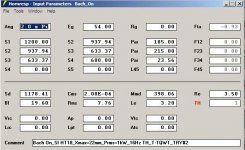 T_TQWT_TRY2_Input.jpg37.8 KB · Views: 351
T_TQWT_TRY2_Input.jpg37.8 KB · Views: 351 -
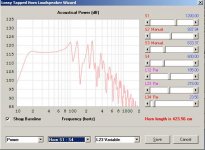 T_TQWT_TRY2_Wizard_SPL_raw.jpg34.5 KB · Views: 357
T_TQWT_TRY2_Wizard_SPL_raw.jpg34.5 KB · Views: 357 -
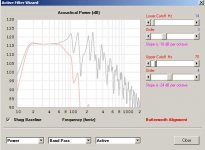 T_TQWT_TRY2_Wizard_SPL_filtered.jpg29.1 KB · Views: 364
T_TQWT_TRY2_Wizard_SPL_filtered.jpg29.1 KB · Views: 364 -
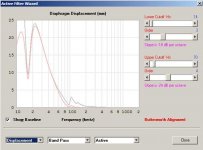 T_TQWT_TRY2_Wizard_Displacement_filtered.jpg27.3 KB · Views: 345
T_TQWT_TRY2_Wizard_Displacement_filtered.jpg27.3 KB · Views: 345 -
 T_TQWT_TRY2_Wizard_Schematic.jpg23.1 KB · Views: 337
T_TQWT_TRY2_Wizard_Schematic.jpg23.1 KB · Views: 337 -
TTQWT_2.txt981 bytes · Views: 79
Last edited:
Oliver.
Nice work!
One thing I keep seeing with the Ht18 driver is a simulation stopping at 24 to 25mm excursion. The driver has another 18mm mechanical before you run out of suspension.
Yes the distortion will go up. But only on occasion of requiring that amount of output.
So you have a bit more headroom with your design.
Nice work!
One thing I keep seeing with the Ht18 driver is a simulation stopping at 24 to 25mm excursion. The driver has another 18mm mechanical before you run out of suspension.
Yes the distortion will go up. But only on occasion of requiring that amount of output.
So you have a bit more headroom with your design.
- Status
- Not open for further replies.
- Home
- Loudspeakers
- Subwoofers
- Tapped Horn Cabinet for 16 Hz. organ speaker
